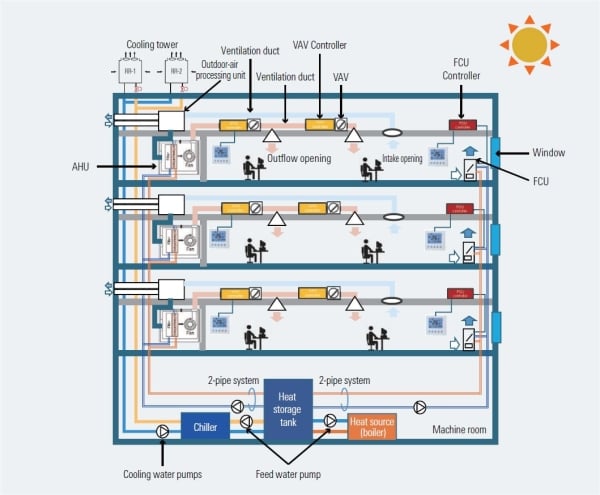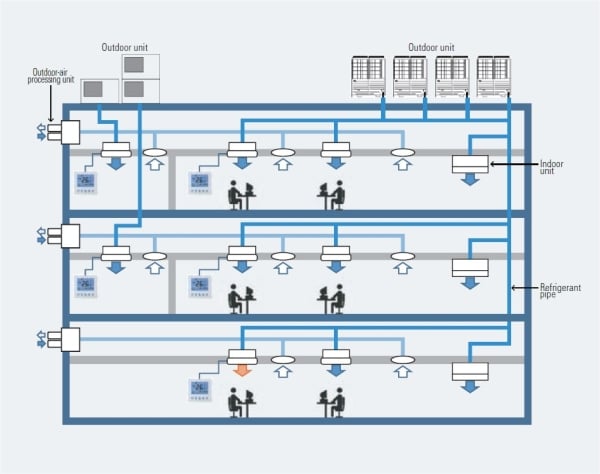Renesas HVAC systems realize convenience and energy efficiency through motor control and sensing technologies. HVAC building automation system can be divided into two types: central air conditioning and individual air conditioning.
Central Air Conditioning System
As illustrated in Figure 1, in a central air conditioning system, a heat source in a single location is used to circulate air, water, or steam to the various rooms, and exchange heat, in order to cool or heat each room to the specified temperature. The chiller refrigerates water for use as a refrigerant, circulates it to the various rooms, and exchanges heat. The cooling water gradually becomes warmer. In the cooling tower on the roof, the water is chilled through contact with air and then reused. Pumps are used to recirculate the water. The heat source (boiler) is powered by gas, oil, or electricity, and heats water in a vessel to produce hot water or steam. To heat the rooms, this hot water or steam is circulated through the rooms, and heat exchange takes place.
Either a pair of two pipes or a set of four pipes can be used to circulate the cold or hot water. There are outgoing and incoming hot-water and cold-water pipes used to distribute the hot and cold water to air handling units (AHUs), fan coil units (FCUs), etc.
In a two-pipe system, the same pipes are used for both hot and cold water, switching from one to the other depending on the season and whether heating or cooling is required. Heating and cooling operations cannot take place at the same time. On the other hand, if the cooling and heating coils built into the AHUs, FCUs, etc., are each equipped with their own outgoing and incoming pipes, simultaneous heating and cooling operation is possible within the same building. Such an arrangement is called a four-pipe system, based on the total number of pipes used.
An outdoor-air processing unit (or total heat exchanger) extracts the heat or cold from indoor air that is expelled to the outside (exhaust) and transfers it to fresh air from outside, thereby minimizing the difference in temperature between the indoor air and the fresh air from outside. The air handling unit uses cold water, hot water, or steam supplied by the heat source unit to adjust the temperature and humidity of the air, which is then supplied to the rooms.
HVAC systems use air, water, or refrigerant as the medium for heat exchange. Some central air conditioning systems use a method called variable air volume (VAV), in which valves are used to adjust the volume of cool (or warm) air passing through the ducts. In a water-cooled system, cold or hot water is circulated via pipes, and FCUs perform heat exchange to adjust the temperature of each room.
Individual Air Conditioning System
In an individual air conditioning system, the refrigerant gas is circulated and exchanges heat. One typical example is a building multiple air conditioner system. The temperature can be set for each room, and simultaneous heating and cooling operations are possible. Sometimes central air conditioning and individual air conditioning are used in combination, depending on the size of the building and its purpose.
Additional Information
Renesas provides lists of units requiring motor control that are used in these two types of air conditioning systems. The use of inverters and brushless DC motors is increasing in variable-speed motor control applications requiring energy efficiency.


